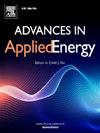The impact of hydrogen on decarbonisation and resilience in integrated energy systems
IF 13.8
Q1 ENERGY & FUELS
引用次数: 0
Abstract
The lack of clarity and uncertainty about hydrogen's role, demand, applications, and economics has been a barrier to the development of the hydrogen economy. In this paper, an optimisation model for the integrated planning and operation of hydrogen and electricity systems is presented to identify the role of hydrogen technologies and linepack in decarbonising energy systems, improving system flexibility, and enhancing energy system security and resilience against extreme weather events. The studies are conducted on Great Britain's (GB) 2050 net-zero electricity and gas transmission systems to analyse the hydrogen transport and capacity requirements within the existing infrastructure under different scenarios. This includes sensitivities on the level of flexibility, high gas prices, hydrogen production mixes, enabled reversibility of electrolysers, electricity generation cost, and hydrogen storage facilities. In all sensitivity scenarios, efficient hydrogen transport within the existing infrastructure is enabled by the optimal allocation of green and blue hydrogen sources, distributed storage facilities, and the intra-day flexibility provided by linepack. The findings highlight that increased renewable deployment transfers intermittency to the hydrogen network, requiring greater linepack flexibility compared to the current paradigm (up to 83%). Furthermore, the necessity of synergy between different gas and electricity systems components in providing flexibility, security, and resilience is quantified.
氢对综合能源系统脱碳和恢复力的影响
氢的作用、需求、应用和经济性缺乏明确性和不确定性一直是氢经济发展的障碍。本文提出了氢和电力系统综合规划和运行的优化模型,以确定氢技术和线路包在能源系统脱碳、提高系统灵活性、增强能源系统安全性和抵御极端天气事件的能力方面的作用。这些研究是在英国2050年净零电力和天然气传输系统上进行的,以分析不同情景下现有基础设施内的氢气运输和容量需求。这包括灵活性水平的敏感性、高天然气价格、制氢混合、电解槽的可逆性、发电成本和储氢设施。在所有敏感的情况下,现有基础设施内的高效氢运输是通过绿色和蓝色氢源的最佳分配、分布式存储设施以及线路包提供的日间灵活性来实现的。研究结果强调,可再生能源部署的增加将间歇性地转移到氢气网络,与目前的范例(高达83%)相比,需要更大的线路包灵活性。此外,还量化了不同燃气和电力系统组件在提供灵活性、安全性和弹性方面协同作用的必要性。
本文章由计算机程序翻译,如有差异,请以英文原文为准。
求助全文
约1分钟内获得全文
求助全文

 求助内容:
求助内容: 应助结果提醒方式:
应助结果提醒方式:


